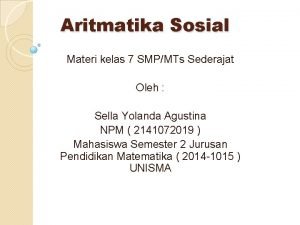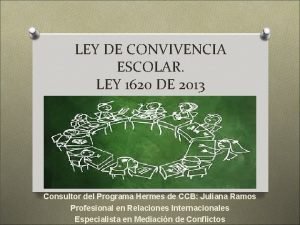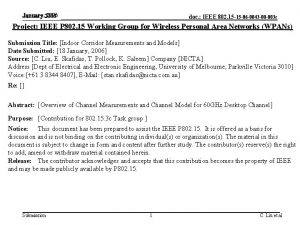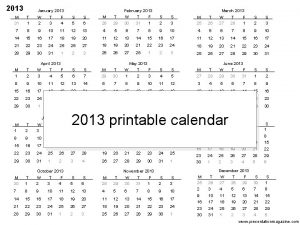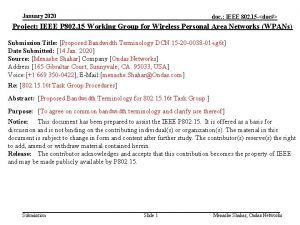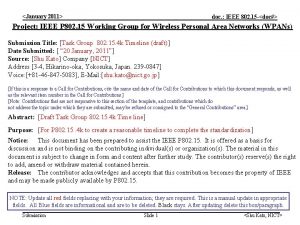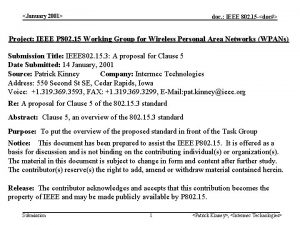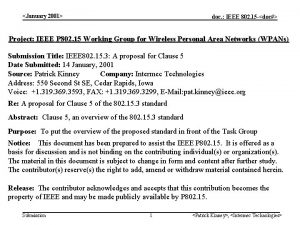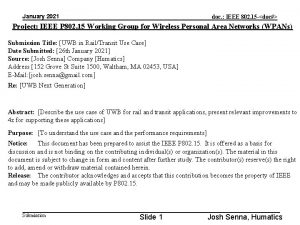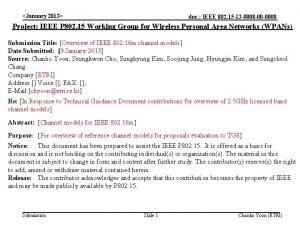January 2013 doc IEEE 802 11 130129 r












- Slides: 12

January 2013 doc. : IEEE 802. 11 -13/0129 r 0 SIGNAL TO NOISE+INTERFERENCE (SNIR) VARIATIONS ON MULTIPLE TVWS CHANNELS Authors: January 15, 2013 UPDATE: This contribution contains additional simulation results for 10 d. B SNIR difference on 2 accessed TV channels, one an adjacent channel, the other a non adjacent channel. The simulations also address an intermediate case with a 4 d. B SNR difference due to lower TX power. Submission 1 Joe Kwak, Inter. Digital

January 2013 doc. : IEEE 802. 11 -13/0129 r 0 Simulation Overview • Main goal: • Compare 2 channel MAC layer throughputs using 2 cases: A. B. MAC layer channel aggregation using one interleaver on each channel and independent MCS selection based on each channel SNIR PHY layer bonding using a single interleaver for both channels and a common MCS on bonded channels (11 af baseline) • Simulation assumptions • Rms Delay Spread: 100 ns • Two-channel operation • Packet length • 1000 bytes for PHY bonding (Case B) over 2 channels • 500 bytes for MAC layer aggregation (Case A) on each channel • Same noise level on both channels • Different transmit power on two channels • P_Tx 1 = 40 mw (adjacent) P_Tx 2 = 100 mw (non-adjacent) • GI = 6 µs • Target PER: 10% --MCS adaptation threshold for BOTH cases Submission 2 Joe Kwak, Inter. Digital

January 2013 doc. : IEEE 802. 11 -13/0129 r 0 Consider Two Cases • Case A: MAC layer aggregation • Each channel has independent MCS • One interleaver on one channel • MCS selection on each channel follows Table 23 -19 of 802. 11 af specs • Case B: 802. 11 af- PHY layer bonding • One interleaver over two channels • Same MCS for two aggregated channels • One encoder and same modulation modes • MCS selection on two aggregated channel follows Table 23 -23 of 802. 11 af specs Submission 3 Joe Kwak, Inter. Digital

January 2013 doc. : IEEE 802. 11 -13/0129 r 0 Simulation Results - PER Performances of one channel(Case. A) Submission 4 Fig. 1 PER vs. SNR for a single 6 MHz TVWS channel Joe Kwak, Inter. Digital

January 2013 doc. : IEEE 802. 11 -13/0129 r 0 Simulation Results - PER Performances of two-bonded - channel (Case B) Fig. 2 PER vs. (S 1+S 2)/2 N 0, where S 1 and S 2 are transmit power for channel 1 and channel 2 respectively, N 0 is the noise level on each channel, S 2 = 2. 5 S 1 (Tx. Power Difference on two channels = 4 d. B) Submission 5 Fig. 3 PER vs. (S 1+S 2)/2 N 0, where S 1 and S 2 are transmit power for channel 1 and channel 2 respectively, N 0 is the noise level on each channel, transmit power on channel 2 is 2. 5 times of transmit power on channel 1, i. e. , S 2 = 2. 5 S 1 and interference on channel 1 is 5 d. B higher than the noise level and no interference on channel 2. Joe Kwak, Inter. Digital

January 2013 doc. : IEEE 802. 11 -13/0129 r 0 Simulation Results- Received SNIRs and MCS’s for 4 d. B Tx Power Difference Fig. 4 Case. A: SNIRs and MCS's on two channels for Tx. Pow. Diff=4 d. B and no interference on both channels (MCS mapping is based on Fig. 1 on Slide 4) - Inter. Digital SINR for Channel N+4 MCS for Channel N+1 MCS for Channel N+4 50 45 40 35 30 25 20 15 10 5 0 8 7 6 5 4 3 2 1 0 MCS Index SNR(d. B) SINR for Channel N+1 50 55 60 65 70 75 80 90110130150170190210230250270290310330350370390410430450470490510 distance (m) Fig. 5 Case B: SNIR and MCS of two-bonded channel for Tx. Power Diff = 4 d. B and No Interference on CH N+1 (MCS mapping is based on Fig. 2 on Slide 5) – PHY layer bonding MCS for two-bonded channel 50 8 7 6 5 4 3 2 1 0 SNR(d. B) 40 30 20 10 0 MCS Index SNR/SINR on Two-bonded-channel 50 55 60 65 70 75 80 90 110130150170190210230250270290310330350370390410430450470490510 distance (m) Submission 6 Joe Kwak, Inter. Digital

January 2013 doc. : IEEE 802. 11 -13/0129 r 0 Simulation Results - Throughput Comparison between MAC layer aggregation and PHY bonding with single interleaver and a common MCS SNR difference between two channels = 4 d. B Tput Performance vs. Distance for Tx. Power Diff = 4 d. B and No Interference on CH N+1 Tput for MAC layer aggregation 25. 00% 15. 00% -5. 00% 50 60 70 80 110 150 190 230 270 310 350 390 430 470 510 -15. 00% distance(m) Fig. 6 MAC layer throughput comparison between Independent MCS selection (MAC layer aggregation) and PHY layer bonding with single interleaver and a common MCS Submission 7 MAC layer Aggregation(Independent MCS Selection) over PHY Layer Bonding (Common MCS) Tput Gain 16 14 12 10 8 6 4 2 0 Tput for PHY layer bonding Case B 50 55 60 65 70 75 80 90 110 130 150 170 190 210 230 250 270 290 310 330 350 370 390 410 430 450 470 490 510 Tput(Mbps) Case A Tput Gain vs. Distance for Tx. Power Diff = 4 d. B and No Interference on CH N+1 -25. 00% distance (m) Fig. 7 Throughput Gain of Independent MCS selection (MAC layer aggregation) over PHY layer bonding with a common MCS Joe Kwak, Inter. Digital

January 2013 doc. : IEEE 802. 11 -13/0129 r 0 Simulation Results- Received SNIRs and MCS’s for 4 d. B Tx Power Difference and 5 d. B Interference Difference for 10 d. B SNIR difference SNIR 8 Case A: SNIRs and MCS's on two channels for Tx. Pow. Diff=4 d. B and Interference to Noise Ratio on CH N+1=5 d. B (MCS mapping is based on Fig. 1 on Slide 4) - Inter. Digital SINR on CH N+4 MCS on CH N+1 MCS on CH N+4 50 8 40 6 30 4 20 2 10 0 MCS Index SNIR(d. B) SINR on CH N+1 0 50 55 60 65 70 75 80 90 110 130 150 170 190 210 230 250 270 290 310 330 350 370 390 410 430 450 470 490 510 distance (m) SNIR 9 Case B: Combined SNIR/SNR and MCS for two-bonded-channel for Tx. Pow. Diff=4 d. B and Interference to Noise Ratio on CH N+1 = 5 d. B (MCS mapping is based on Fig. 3 on Slide 5) – 802. 11 af Combined SNR on Two-bonded Channel MCS for two-bonded-channel 50 8 7 6 5 4 3 2 1 0 SNIR(d. B) 40 30 20 10 0 MCS Index Combined SINR on Two-bonded Channel 50 55 60 65 70 75 80 90 110 130 150 170 190 210 230 250 270 290 310 330 350 370 390 410 430 450 470 490 510 distance (m) Submission 8 Joe Kwak, Inter. Digital

January 2013 doc. : IEEE 802. 11 -13/0129 r 0 Simulation Results - Throughput Comparison between MAC layer aggregation and PHY bonding with a single interleaver and a common MCS SNR difference between two channels = 10 d. B (Tx. Pow. Diff = 4 d. B, Interference. Diff = 5 d. B) Tput Gain vs. Distance for Tx. Pow. Diff=4 d. B and Interference to Niose Ratio on CH N+1 = 5 d. B Tput vs. Distance for Tx. Pow. Diff=4 d. B and Interference to Niose Ratio on CH N+1 = 5 d. B MAC layer aggregation over PHY layer bonding Case ATput for MAC layer aggregation Case. Tput B for PHY layer bonding 90. 00% 80. 00% 14 70. 00% 12 60. 00% 10 50. 00% Tput Gain Tput(Mbps) 16 8 6 40. 00% 30. 00% 20. 00% 4 10. 00% 2 0. 00% 50 55 60 65 70 75 80 90 110 130 150 170 190 210 230 250 270 290 310 330 350 370 390 410 430 450 470 490 510 0 -10. 00% 50 60 70 80 110 150 190 230 270 310 350 390 430 470 510 distance (m) Fig. 7 MAC layer throughput comparison between Independent MCS selection (MAC layer aggregation) and PHY layer bonding with single interleaver and a common MCS Submission 9 Fig. 8 Throughput Gain of Independent MCS selection (MAC layer aggregation) over PHY layer bonding with a common MCS Joe Kwak, Inter. Digital

January 2013 doc. : IEEE 802. 11 -13/0129 r 0 Weak Channel Throughput Contribution in MAC Layer Aggregation (Case A) SNIR difference between two channels = 10 d. B SNR difference between two channels = 4 d. B Weak Channel Contribution 60. 00% 50. 00% 40. 00% Percentage 60. 00% 30. 00% 20. 00% 10. 00% 50 60 70 80 110 150 190 230 270 310 350 390 430 470 510 distance(m) Submission 10 30. 00% 50 60 70 80 110 150 190 230 270 310 350 390 430 470 510 distance(m) Joe Kwak, Inter. Digital

January 2013 doc. : IEEE 802. 11 -13/0129 r 0 Discussions • In the high SNR range, MAC layer aggregation provides slightly lower throughput than PHY layer bonding • The highest MCS is selected in both cases • Higher overhead ratio of two packets generated for one transmission in MAC layer aggregation than one packet generated for two bonded channels in the PHY layer bonding case • For higher SNIR difference and larger distance, the throughput gain of MAC layer aggregation becomes evident • Some gain drops at certain distances • Quantization error on MCS selection • PER curves of MCS 2 and MCS 3 are crossed over for the case that SNIR difference is 10 d. B (Fig. 3) • Gain of MAC layer aggregation over PHY layer bonding Submission 11 SNR Difference Maximum Gain Average Gain (110 to 510 m) 4 d. B 19% -5. 7% 10 d. B 82% 42% Joe Kwak, Inter. Digital

January 2013 doc. : IEEE 802. 11 -13/0129 r 0 Summary • Highly variable SNIR levels on aggregated TVWS channels: • Different transmit power limits on adjacent/nonadjacent TVWS channels • High interference levels on on DTV adjacent channels from DTV adjacent channel emissions. • Single MCS utilization for bonded channels leads to • • significant degradation and waste of spectrum Independent MCS for multichannel permits efficient use of resources in real TVWS environments. TGaf draft requires use of single MCS for multichannel and should be modified to add an option to permit effective multichannel operation using independent MCS selection. Submission 12 Joe Kwak, Inter. Digital











